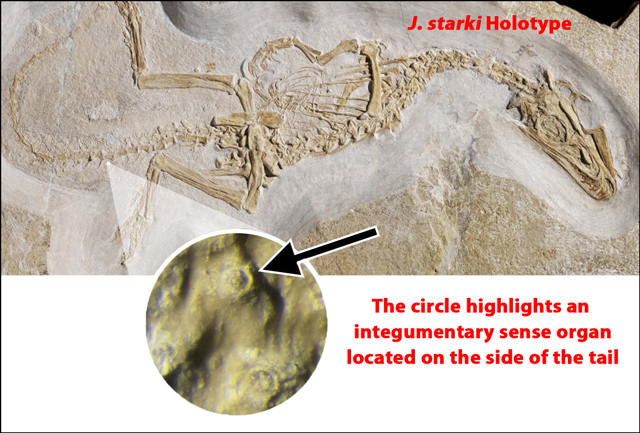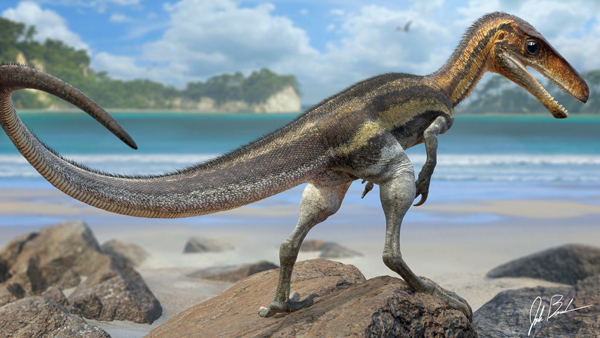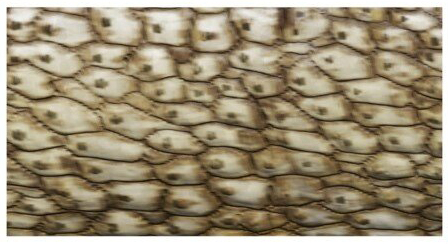Juravenator and a “Tale” of Sensory Scales
Researchers writing in the academic journal “Current Biology”, have revealed how dinosaurs may have made sense of their surroundings using special sensory nodes embedded in the scales on their skin. A new paper focusing on the small, theropod Juravenator starki from the Torleite Formation (upper Kimmeridgian), Solnhofen, Bavaria, (Germany), reports on the discovery of dermal structures along the side of the dinosaur’s tail resembling the integumentary sense organs found in extant crocodiles.
Getting a Sense of Dinosaur Senses

Picture credit: Bell et al Current Biology with additional annotation by Everything Dinosaur
Juravenator starki
Once thought to be a close relative of the contemporary Compsognathus longipes, Juravenator is known from a single, beautifully preserved fossil specimen (JME Sch 200), found in a limestone quarry in 1998. Although squashed flat, the specimen is mostly articulated and complete with only some caudal vertebrae missing. It is a juvenile and as such, placing it within the Theropoda has proved problematic. The taxonomic position is uncertain, but it has been suggested that it could represent a basal member of the Coelurosauria or perhaps a primitive member of the Maniraptora.
The genus name is derived from the Bavarian Jura mountains and “venator” – Latin for “hunter”. The species (trivial) name honours the Stark family who owned the quarry where the sixty-centimetre-long dinosaur fossil was discovered.
Soft tissue representing body scales have been identified associated with the lower leg bones and between the 8th and 22nd caudal vertebrae. Other soft tissue structures have been found probably representing preserved tendons and ligaments. It is these dermal structures that have been the centre of this new study.
A Life Reconstruction of the Late Jurassic Theropod Juravenator starki
Picture credit: Jake Baardse
Specialised Scales
Scientists are aware that early in the evolution of the first truly terrestrial tetrapods epidermal scales evolved to provide an effective barrier against ultraviolet radiation and to prevent excessive water loss. This evolutionary development meant that stem reptiles were no longer constrained by having to stay close to freshwater like their amphibian ancestors. Epidermal scales in extant reptiles are not simple, inert structures but can perform a suite of functions and assist in how the animal senses its environment.
Researchers Dr Phil Bell (University of New England) in Armidale, Australia along with his colleague Dr Christophe Hendrickx, from the Unidad Ejecutora Lillo in San Miguel de Tucumán, (Argentina), both specialists in dinosaur dermatology, identified a unique scale type with distinctive, prominent circular nodes on the preserved integumentary covering on the tail of Juravenator. They interpret these raised nodes as integumentary sense organs, analogous to those found today in living crocodilians.
Dr Bell commented:
“Few people pay much attention to dinosaur skin, because it is assumed that they are just big, scaly reptiles. But when I looked closely at the scales on the side of the tail, I kept finding these little ring-like features that didn’t make sense; they were certainly unlike other dinosaur scales.”
Integumentary Sense Organs Identified in a Dinosaur
Picture credit: Bell et al Current Biology
The First Direct Evidence of Integumentary Sense Organs
The surprising presence of such structures suggests the tail of Juravenator played a role in how this dinosaur sensed the world around it. This is the first direct evidence of such structures being present on the skin of a dinosaur.
The shape and the orientation of the teeth, especially those in the upper jaw suggest Juravenator ate fish (piscivore). During the Late Jurassic, this part of Europe was covered by a warm, tropical, shallow sea with numerous small islands. This archipelago was home to a number of dinosaurs including the famous “urvogel” Archaeopteryx. As crocodiles are aquatic predators, the research team speculate that Juravenator may have been an aquatic hunter too.
Alligators have integumentary sense organs on their snout, whereas crocodiles have these special scales all over their body including the tail. These sensory nodes help these reptiles to detect temperature changes, chemical signals in the water as well as having tactile properties. Although the entire integumentary covering of Juravenator is unknown, this lithe dinosaur could have submerged its tail to help it detect the movement of prey underwater.
To read an article about the sense of smell in the Dinosauria: Don’t Get Sniffy About Dinosaur Sense of Smell.
The scientific paper: “Crocodile-like sensory scales in a Late Jurassic theropod dinosaur” by Phil R. Bell and Christophe Hendrickx published in Current Biology.
The Everything Dinosaur website: Everything Dinosaur.








Leave A Comment